Elly
Administrator
Posts: 29,887
|
Post by Elly on Jul 5, 2005 22:02:29 GMT 10
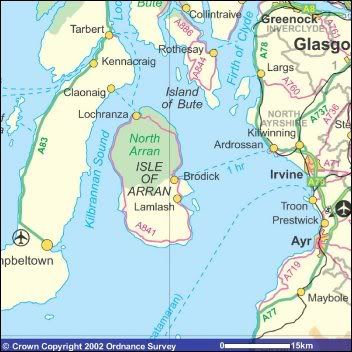 Arran is one of the most accessible of the Scottish islands and one of the most southerly. The line between the Highlands and Lowlands of Scotland divides the island almost exactly in two and Arran mirrors the differing landscapes. A 'Scotland in miniature', the north is ruggedly mountainous and sparsely populated, the south milder and home to the majority of the 4,500 people who live here. The ferry from Ardrossan docks at Brodick, the island's main town, which provides a good base for exploring Arran. There are tourist facilities in the town and Brodick is home to one of Arran's many golf courses. It also boasts Brodick Castle, set in parkland two miles north of the town and open to visitors during the summer months (the gardens and country park are open all year). Arran Folk Festival takes place here in early June. There is also a Heritage Museum in the town.  Brodick Village 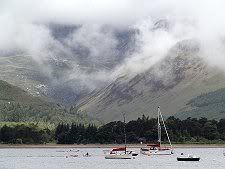 Glen Rosa and Brodick Harbour |
|
|
|
Post by dreamy on Jul 6, 2005 4:06:13 GMT 10
Oh, I love the pics, Elly, especially the one of Glen Rosa. Another "must- to - see" then. Thanks for this post.
|
|
Elly
Administrator
Posts: 29,887
|
Post by Elly on Jul 6, 2005 11:04:27 GMT 10
Machrie Moor Stone Circles The Isle of Arran, off the West Coast of Scotland, has many stone circles and standing stones dating from the Neolithic period and the early Bronze Age. The finest collection of circles can be found on Machrie Moor, on the West of the island. The whole moorland is littered with the remains of early man, from hut circles to chambered cairns and solitary standing stones. The focus of the site is upon six stone circles of varying structure, concentrated in a small area of the moorland. The most distinguishable of the circles consists of three upright red sandstone pillars, the tallest of which is just over 18 feet high. Many of the other stones within the circle have fallen and two of the granite boulders within the circle have been carved into millstones still in situ. The other tall pillar closer to the abandoned farmstead, looks like a solitary standing stone but is part of a larger circle, the stones of which have been removed or lie buried. The second most interesting circle is a double ring of squat granite boulders called Fingal's Cauldron Seat. The outer circle is egg shaped but the inner ring of eight stones forms an almost perfect circle. When this circle was excavated a ruined cist was found but it did not contain any traces of burial. 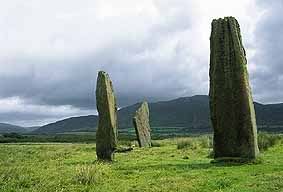 Three tall stones (the tallest is 5.3 m high), which were brought from an area lying two miles away. The site was dated to 2900 BC. History Although the stone circles date from around 1800 to 1600 BC during the Bronze Age period, there is plenty of evidence to suggest much earlier use of the site during the Neolithic period. At this time several timber circles were erected on the moor in the general area where some of the stone circles now lie. 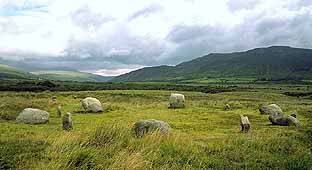 The main circle consisted of about fifty tall posts with an inner ring of taller posts in a horseshoe formation. The wood circle was in use for many hundreds of years, during which time other timber circles were also created. After a long period of activity the site seems to have fallen out of favour, as the archaeology suggests a return to agricultural usage. The focus returned in about 1800BC when the construction of the stone circles was commenced. The main population at the time lived in small round huts, the remains of which are to be found to the West of the stone circles. It is likely that the circles were the focus of ritual activity, perhaps only accessible to a selected priesthood of the population but nobody really knows for sure. 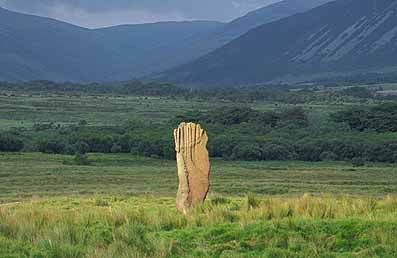 Machrie Moor, Arran It is not clear when the site finally lost its ritual function, but it may have been a change in the climate that forced settlers to move elsewhere. The blanket peat bogs that now cover the moor developed after the circles had been completed and were the result of this shift in climate. Folklore and Ancient Astronomy It is quite common in folklore to find that ancient circles of stone have become associated with legendary figures and giants. These legendary figures were often used to explain the origin of the stones. At Machrie the double circle, Suide Choir Fhionn or Fingal's Cauldron Seat, is named after the legendary warrior and giant Fingal, who is most likely derived from the Irish Warrior God Finn MacCumhail. According to the tradition, Fingal used the stone with the hole in it in the outer circle to tether his dog Bran, while he ate a meal within the inner ring. Fingal and his dog Bran are attached to a number of other Scottish sites. The double circle is the only that is associated with folklore, and some people have suggested that it served as the focus of the site. As with many stone circles they may have served some form of astronomical function, related to the major festivals in the ancient calendar. John Barnatt who surveyed the area in 1978, suggested that the stone circles were in general alignment with a notch on the skyline were Machrie Glen divides into two. This notch is intersected by the sun on Midsummer's morning. Many stone circles are aligned in this way, and the changing seasons would have been much more important to ancient man, Midsummer being the longest day of the year and the beginning of the slow march to Winter. |
|
Elly
Administrator
Posts: 29,887
|
Post by Elly on Jul 6, 2005 21:13:39 GMT 10
Arran's history is linked with the earliest Scottish people, the Picts. They left their mark with rare writing at Kings Cave and stone circles over the Island. 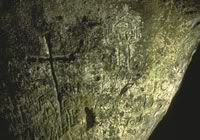 At Blackwaterfoot the main road north heads inland for a few miles. In doing so it bypasses Drumnadroon Point, well worth exploration on foot from Blackwaterfoot. The Point is home to the largest Iron Age fort on Arran, while further north is a feature known as the King's Cave. According to some this is the place where Robert the Bruce encountered the spider whose efforts convinced him to try again: and thereby changed the course of Scottish history. According to others the very story itself was invented by Sir Walter Scott in the early 1800s. 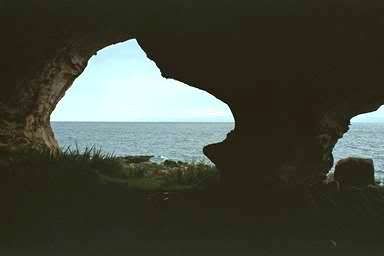 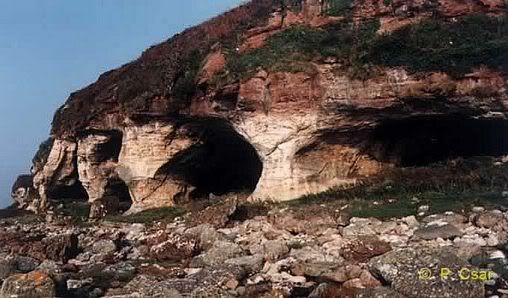 The cave has several Viking carvings on the central pillar. The most interesting one seems to represent a man holding what might be a bow over the top of his head. However, it is not known, what the instrument really represents. Another carving might be a twohanded sword or cross, suggesting that the cave might once have been used for religious purposes. Other carvings include the image of a horse. This large sea cave was formed 6,000 years ago, when the sea level was higher than now. The cliffs of Drumadoon, around the cave, and most other cliffs around Arran, were formed 10,000 years ago during the last cold phase of the Ice Age. 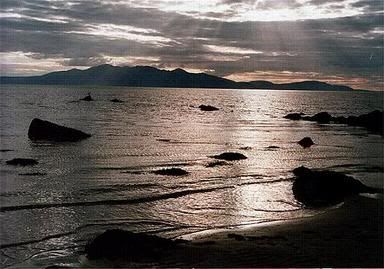 Arran has a timeless mystical appeal adding to the belief of some that Arran was actually Avalon, the Blessed Isle. 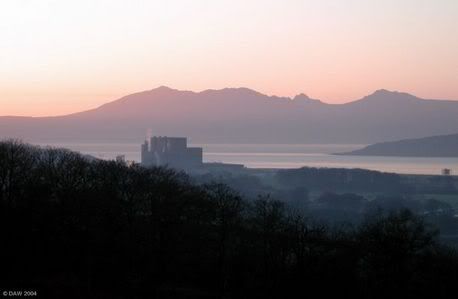 Sleeping Warrior, named for the profile the mountains create of a warrior sleeping with his hands laid on his breast, adding to the belief that Arran is 'Avalon' and the warrior King Arthur.(to see the outline of the warrior properly it is best to tilt your head just slightly to your right as normally when viewing in on Arran you would be looking up at the slopes) |
|
Elly
Administrator
Posts: 29,887
|
Post by Elly on Jul 7, 2005 13:46:35 GMT 10
Oh, I love the pics, Elly, especially the one of Glen Rosa. Another "must- to - see" then. Thanks for this post. glad you enjoy them Dreamy, yes Arran is a beautiful and interesting place  |
|
Elly
Administrator
Posts: 29,887
|
Post by Elly on Jul 8, 2005 23:21:54 GMT 10
Perhaps the most scenically attractive of Arran's villages, Lochranza is located on the loch, Loch Ranza, from which it takes its name. Surrounded on three sides by hills and facing the imposing grey ruin of its castle placed dramatically on a shingle spit sticking into the Loch, a visit is an essential part of any Arran trip. Yet, traditionally, Lochranza has been much less visited than the resort villages of Brodick, Lamlash, and Whiting Bay in the east and south east of the island. 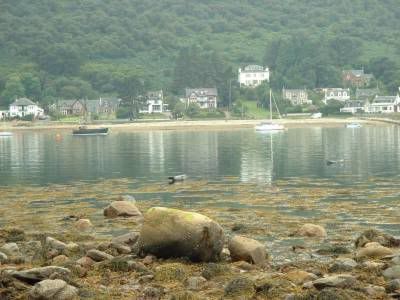 A number of factors are helping remedy this. The first is the popularity of the summer ferry route from Lochranza pier to Claonaig, on the Kintyre Peninsula south of Tarbert. This offers a range of options for those interested in incorporating Arran into a wider tour of Western Scotland. The other major recent deveopment in Lochranza was the opening by the Queen in 1997 of the Visitor Centre for the Isle of Arran Distillery. The distillery itself had been opened in 1995 and was the first (legal) distillery on Arran for 150 years. It can be found in purpose built premises at the southern end of the village. Visitors who find their way to Lochranza via the traditional "clockwise" tour of the island, or via the ferry from Kintyre, will be amazed by the sight that greets them as the road crests the end of the glen south of Lochranza on the road to Brodick. Here you are confronted by some of the most jagged, brutal and stunningly impressive mountain scenery anywhere in Scotland. On a par with the Cuillin of Skye, but in many ways more impressive through being smaller and much closer to the road. This village on the northern tip of Arran is overlooked on several sides by hills where you may see deer. A small vehicle ferry takes you from here over to Claonaig on the Kintyre Peninsula on the mainland opposite. 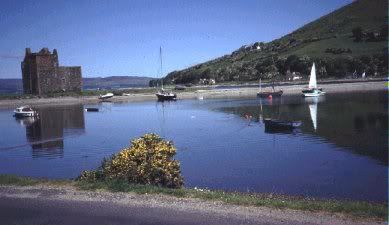 |
|
|
|
Post by dreamy on Jul 9, 2005 7:15:51 GMT 10
It seems as if Arran was worth spending the whole holidays there in order to explore it all. It is a beautiful island , very impressing!
|
|
Elly
Administrator
Posts: 29,887
|
Post by Elly on Jul 10, 2005 11:26:31 GMT 10
LOCHRANZA CASTLE This is superbly located on a curved shingle spit that projects from the southern side of Loch Ranza. We have heard it claimed that Lochranza Castle has literary connections, being used as the basis for the castle in the Tintin adventure "The Black Island". Fans of Hergé will have to decide for themselves. Lochranza Castle is normally locked. The key can be obtained from Lochranza Stores. The castle is L-shaped in plan. Much of what can be seen today is the result of rebuilding in the 16th Century, but there are remnants from the original castle built before 1261 for the MacSweens. In 1262 it was granted by Alexander III to Walter Stewart, the Earl of Menteith. In 1306 it is said to have been the spot at which Robert the Bruce landed on his return from Ireland, and before his successful bid for the Scottish Crown. It was certainly in the possession of his grandson when he became King Robert II of Scotland in 1371. It subsequently saw use as a royal hunting lodge. Several further changes of ownership followed, during which Lochranza Castle gradually became transformed into the tower house we see today: and gradually turned to face towards the village rather than the sea as it had before.  During the 1490s it was used as a base from which James IV could attack the MacDonalds, the Lords of the Isles. 1614 saw its occupation by James VI; and Cromwell occupied it in the 1650s. Then, following the foreclosure of a mortgage, it found its way in 1705 into the hands of the Hamiltons, like so much else in Arran. It has been disused since the end of the 18th Century. Arran Distillery History of Scotland's Newest Malt Whisky Distillery A dynamic new force in the scotch whisky industry, Isle of Arran Distillers is one of the few remaining independent distilleries in Scotland. We are based at Lochranza on the Isle of Arran, one of the most beautiful and famous in Scotland which lies off the West Coast between Ayrshire and Kintyre. Our company was set up by Harold Currie, who was previously Managing Director of Chivas (Seagrams) and House of Campbell (Pernod Ricard). 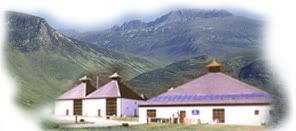 Arran is a unique island known as 'Scotland in Miniature', for it has all of the scenery of Scotland, with mountains and lowlands, glens, lochs and royal castles (including one at Lochranza). Early in the 19th century there were more than 50 whisky distilleries on Arran, most of them illegal and carefully hidden from the eyes of the taxmen. The malt was acclaimed at the time as the best in Scotland, only rivalled by those from the 'Glen of Livet'. In 1995 we opened a new distillery on Arran, in one of the most beautiful locations in Scotland. We use only the traditional methods of distilling, with wooden washbacks and copper stills designed to our exact specification. The location offers perfect water for whisky production, cleansed by granite and softened by peat as it comes down from the mountain above. The atmosphere of sea breezes and clear mountain air together with the warm flow of the Gulf Stream matures the Arran Malt to perfection in earth floored warehouses. We are now developing sales of our brands, across the world in Europe, Asia and the Americas. Arran is a unique island, and our products are similarly unique. We use no peat in the production process and no caramel for artificial colouring - unlike most other whisky companies. As a result our products are rightly described as 'the true spirit of nature'. Production commenced at 14.29 on Thursday 29th June 1995 and during the official opening ceremony on August 17th two golden eagles, who live on the mountain behind the Distillery, provided a fly past as a 'thank you' for halting building work for several weeks to allow them to hatch their chicks. On a warm summer's day they can still be found, floating high on the thermal currents, before dropping like a stone hunting their quarry. |
|
|
|
Post by krystal on Jul 13, 2005 23:53:09 GMT 10
Great work Elly very interesting i can see you have put alot of hard work into this thread and feel very passionate about it.   |
|
Elly
Administrator
Posts: 29,887
|
Post by Elly on Jul 29, 2005 13:28:18 GMT 10
BRODICK CASTLE 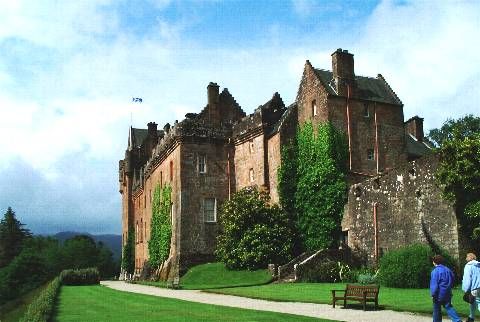 Standing on the northern shores of Brodick Bay this ancient castle, together with its impressive gardens, has been in the care of the National Trust for Scotland since the 1950's. Mostly of 16th century construction there are parts of the Round Tower which date from the 14th century. This Round Tower has associations with King Robert the Bruce (as have several other locations on Arran). The castle was stormed by Sir James Douglas at the beginning of Bruce's claim to the Scottish Crown and it was from this island that the man destined to be King of Scots launched his campaign, sailing from Kingscross (just south of Brodick Bay) to the mainland, having seen the awaited signal beacon burning on the shores of Turnberry (his birthplace). The legend of Robert the Bruce and the spider is well known but there is still much debate as to location of the cave where he was thus inspired to continue his struggle for Scotland's freedom. Arran lays its claim to this location as being the place called King's Cave, on the western shores of the island. The cave certainly was inhabited; recent excavations revealing wall etchings depicting hunting scenes. 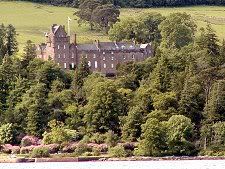 The castle was an ancient seat of the dukes of Hamilton before being placed in the care of the Trust. It is open to the public between Easter and September each year and is well worth a visit. The interior has lavishly furnished apartments with historically important collections of silver, paintings and beautiful porcelain. The ceiling of the drawing room is an outstanding sight, displaying coats of arms from James II through to the 11th Duke of Hamilton. The exterior of the castle is a fine example of Scottish Baronial architecture. In 1844 Princess Marie of Baden, wife of the 11th Duke of Hamilton, added a Victorian extension. The granddaughter, Lady Mary Louise, the Duchess of Montrose lived in the castle until 1957 and in the following year Brodick Castle came into the stewardship of the National Trust for Scotland. The gardens and policies at Brodick form a Country Park. The gardens within the castle grounds are separated into two distinct sections; a formal garden of roses (started in the early 18th century) and a wooded garden containing sub-tropical plants and an outstanding display of rhododendrons which was started in the 1920's by the then Duchess of Montrose. Both gardens are open to the public throughout the year and the National Trust for Scotland provide useful information leaflets on both the gardens and the castle. |
|
|
|
Post by krystal on Jul 29, 2005 21:34:11 GMT 10
Very interesting Elly kepp up the good work!!  |
|
|
|
Post by dreamy on Jul 29, 2005 21:40:44 GMT 10
I love this thread. What a beautiful place this Isle is...it def has something very special. Thank you for your hard work, Elly. I know how hard it is to put all the info and pics together.  |
|